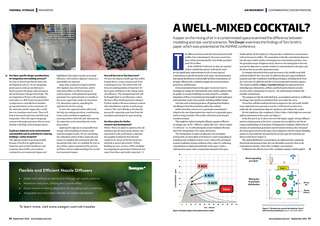




THERMAL STORAGE | INNOVATION Once the alginate/graphite beads have been frozen the CaCl2, which is the active ingredient for thermal storage, is added. This is achieved by submersing the beads into a CaCl2 solution. Initially the beads float and then sink as the final product is created Are there specific design considerations for integration into building services? Yes, but we havent got that far down the development trail yet. We are designing prototypes to scale up our laboratorybased systems into larger units and assess the performance changes this brings. The investigations will start with standalone units (akin to a 3kW heater) located within a temperature-controlled test chamber, giving information on the consistency of the materials and the impact they would have on a medium-sized room. Then well look at increased room sizes and full-scale integration. This will require designing systems with project partners who are more familiar with large-scale heating systems. Could you elaborate on its environmental sustainability and its potential for reducing buildings carbon footprint? The alginate market is growing steadily because of its diverse applications in industries such as food, healthcare and cosmetics. Recent life-cycle analyses evaluated its environmental impact and highlighted that improving the processing efficiency will reinforce alginates status as a sustainable raw material. Sugar kelp, composed of approximately 40% alginate, has a lot of promise, and its cultivation offers an efficient means of carbon capture, with substantial upscaling potential. Over approximately six months in the ocean, sugar kelp reaches its maximum CO2 absorption capacity, signalling the optimal time for harvesting. To store the captured carbon effectively, the kelp can undergo pyrolysis, transforming it into a soil-enrichment supplement, securing carbon within the soil. Alternatively, the materials can be stored directly on the deep seabed. Applying this alginate to sustainable heat storage within building envelopes could yield meaningful results. We are calculating the embodied carbon of these materials and expect to complete this assessment after the upcoming trials. Once we establish the true in situ carbon-capture potential of the process, well have a better understanding of its overall environmental impact. Flexible and Efficient Nozzle Diffusers Stable and defined air distribution through set nozzle patterns Maximum induction, utilising the Coanda effect Quick mixture enabling adaptation to changing room conditions Adaptable and renovation-friendly via nozzle adjustment To learn more, visit www.swegon.com/uk/nozzles 66 September 2023 www.cibsejournal.com The alginate/graphite beads after being frozen How will the trial at Tata Steel work? We have developed a small cage that will be located above a waste exhaust stack from a smelting process. The initial trials will focus on small quantities of material (<10 kg) to gain confidence in the charge times and efficiency. The charged materials will be brought back to our laboratory, where the heat will be discharged and evaluated. Further studies will assess moisture content, salt redistribution, and the overall energy evolved. The trial will help us develop the process for capturing waste heat from the steel plant and using it for space heating. Are there plans for further research and development? Plenty! There are plans to: optimise the salt loading to get elevated energy density and maximised cyclic performance; optimise the graphite loading for best thermal conductivity; focus on the best bead size; and look at mixed salt systems. Within building services, we have a PhD candidate investigating the generation of domestic hot water from these and similar materials. CJ